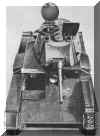The T-26 light tank was the soviet version of the Vickers 6-ton tank. Some Vickers 6-ton tanks arrived to Russia in 1930, and they were evaluated in Leningrad. It was decided to improve the model for later adaption, and these tanks were called TMM-1 and TMM-2. Both of these had many changes from the English model. About 20 TMM tanks were built, and later production order was given to the Bolshevik factory in Leningrad where the newly formed OKMO (design team) were to develop the new vehicle. In 1931, some 120 T-26 Model 1931 were built. Two versions were built: one with MGs in both turrets, and a command tank named T-26TU Model 1931 with a 37mm Model 1928 gun in the right turret, and a MG in the other. Few command tanks were armed with improved long-barrelled 37mm PS-2 Model 1930 gun. Plans were also made to fit a 45mm anti-tank gun, but they were dropped. Also a flamethrowing OT-26 and an engineer tank named ST-26 (Saperskiy Tank - Engineer tank) were built. The ST-26 were built in small numbers, equipped with a 7 meter bridge, and was used by various tank units in mid 1930s. A total of more than 1.000 T-26 Model 1931 and its derivatives in 1932 were built, the last production vehicles having a welded turrets instead of the original riveted ones. In 1930, license rights were purchased from Germany to produce the 37mm Rheinmetall PaK as the 37mm Model 1930 anti-tank gun. It was later found that the 45mm anti-tank gun was more suitable, and therefor a 45mm Model 1931 anti-tank gun was used. The later model T-26 Model 1932 had a single turret mounting a Hotchkiss 37mm high-velocity gun (T-26P). The T-26 Model 1933 were produced in highest quantity, some 5.500 had been built as production ceased in 1936. The T-26 Model 1933 used two different mantles, early vehicles having the drop-forged while latter had one made up of welded parts. After experiences in the conflict with the Japs in the Manchuria region, later T-26 Model 1933 were gradually more and more welded instead of riveted. The last production batches of the T-26 Model 1933 went of the production lines in 1935/36 with two additional DT machineguns; one on a new circular roof hatch for anti-aircraft protection and another in the turret rear. T-26 Model 1933 tanks with radio were used primarily by platoon and coy commanders, and were known as T-26TU Model 1933. In 1937, some T-26 tanks were fitted with a radio and was specified T-26RT. The T-26S Model 1937 was armed with a 45mm Model 1938 L/46 gun. The final model, the T-26S Model 1939 had a 45mm gun, heavier armor and a rounded-off welded hull and a revised turret. Even though the T-26S Model 1939 were uparmored, it could not withstand anti-tank guns or fire from anti-tank rifles. This resulted in small number of T-26 tanks were further uparmored (hull and turret). Frontal armor were now 50mm and the variant were known as T-26E (T-26 ekranami). A T-26A was also produced, armed with a 76.2mm Model 1927/32 howitzer. Only very few T-26A were built due to the overweight turret. From 1938 onwards, the OT-130 was introduced based on the single-turreted T-26. In 1939, Zavod 185 began producing the OT-133, based on the T-26S Model 1939. In 1940 the Kompressor Factory in Moscow developed a new flamethrower for the hull, the 45mm gun in the turret remained. In 1941 a few T-26S tank were modified and known as T-134. A total of 1.336 flame-thrower tanks (all versions) of the T-26 was built. Experimental amphibian T-26PKh tank project were made in mid-1930s, but only a small production run took place. T-26 chassis was used to build many SP-guns, the SU-1 armed with a 76.2mm Model 1927 gun, the SU-5-1 armed with a 76.2mm Model 1902 gun, SU-5-2 armed with a 122mm Model 1910/1930, and SU-5-3 armed with a 152,4mm Model 1931 gun. The most extreme variant of the T-26 was a prototype, KT-26, fitted with wings and a tail unit directly on to the chassis. Bulky pontoons were designed to provide limited amphibious qualities.
T-26 Model 1933 at Central Army Museum Frunze,
Moscow.
Photo provided by: George Mellinger.
T-26 in Action
First seeing action in the borderlands between Mongolia and Manchuria, it later took part with both sides in the Spanish Civil War. The T-26 then continued in Finland in 1940, many were captured and reused by the Finns. The Finns captured a total of 114 T-26 tanks, and they prefered using the T-26 instead of the BT tank. Few survived the German invasion campaigns in Russia of 1941-42. German captured many T-26s, and they were often issued to the infantry as Panzerkampfwagen T-26A/B/C 737-740(r), but few were also converted to Panzerjagers carrying the French 75mm anti-tank gun - designated "7.5cm PaK 97/98 auf Beute Panzer T-26".
Production & Export
A total of 12.600 T-26 tanks were manufactured by STZ in Stalingrad and Factory #174 in Leningrad. The T-26 was exported to several countries: Afghanistan (6 T-26 Model 1931 in 1933), China, Spain (325 T-26 Model 1933) and Turkey (60 T-26 Model 1933).
T-26 Model 1931 and variants - 1.200
T-26 Model 1933
- 5.500
T-26 Model 1937/38
-
T-26 Model 1939
-

T-26 suspension. Photo provided by George Mellinger.
Knocked out T-26 Model 1933 being investigated by Finnish soldiers.

